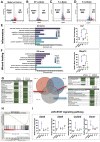Self-Healing Polymeric Puerarin Hydrogel Dressing Promotes Diabetic Wound Healing Through Synergistic Immunomodulation and Tissue-Regenerative Remodeling
- PMID: 40281788
- PMCID: PMC12024557
- DOI: 10.3390/bioengineering12040427
Self-Healing Polymeric Puerarin Hydrogel Dressing Promotes Diabetic Wound Healing Through Synergistic Immunomodulation and Tissue-Regenerative Remodeling
Abstract
Chronic wound healing is a significant challenge in diabetes. Puerarin is an active compound extracted from the traditional Chinese medicine Pueraria lobata. Puerarin has been used in the treatment of diabetes and derives benefits from its antioxidant, anti-inflammatory, antibacterial, and pro-angiogenesis properties, but its efficacy is hampered by poor water solubility and bioavailability. In this study, we designed a polyvinyl alcohol (PVA)-borax-puerarin (BP) hydrogel system that self-assembled via boronic ester bonds. The BP hydrogel exhibited exceptional physical characteristics, including adaptability, injectability, plasticity, self-healing capabilities, and robust compressive strength, as well as good biocompatibility. In the chronic wound diabetic rats model, the BP hydrogel significantly accelerated wound healing, as evidenced by hematoxylin and eosin (HE) staining, as well as Masson and picrosirius red (PSR) staining. RNA-sequencing and multiple immunohistochemistry (mIHC) analyses revealed that the BP hydrogel exerts a therapeutic effect by modulating macrophage polarization, promoting angiogenesis, and regulating collagen remodeling. Our findings suggest that the BP hydrogel represents a promising wound dressing and holds great potential for clinical applications in acute and chronic wound management.
Keywords: biocompatibility; hydrogel; polymeric biomaterials; puerarin; tissue engineering; tissue regeneration; wound dressings; wound healing.
Conflict of interest statement
The authors declare no conflicts of interest.
Figures






Similar articles
-
Ultra-stretchable, tissue-adhesive, shape-adaptive, self-healing, on-demand removable hydrogel dressings with multiple functions for infected wound healing in regions of high mobility.Acta Biomater. 2023 Aug;166:224-240. doi: 10.1016/j.actbio.2023.05.025. Epub 2023 May 18. Acta Biomater. 2023. PMID: 37207743
-
A conductive multifunctional hydrogel dressing with the synergistic effect of ROS-scavenging and electroactivity for the treatment and sensing of chronic diabetic wounds.Acta Biomater. 2023 Sep 1;167:348-360. doi: 10.1016/j.actbio.2023.05.045. Epub 2023 Jun 2. Acta Biomater. 2023. PMID: 37270075
-
An injectable collagen peptide-based hydrogel with desirable antibacterial, self-healing and wound-healing properties based on multiple-dynamic crosslinking.Int J Biol Macromol. 2024 Feb;259(Pt 1):129006. doi: 10.1016/j.ijbiomac.2023.129006. Epub 2024 Jan 2. Int J Biol Macromol. 2024. PMID: 38176492
-
A Multifunctional, Tough, Stretchable, and Transparent Curcumin Hydrogel with Potent Antimicrobial, Antioxidative, Anti-inflammatory, and Angiogenesis Capabilities for Diabetic Wound Healing.ACS Appl Mater Interfaces. 2024 Feb 28;16(8):9749-9767. doi: 10.1021/acsami.3c16837. Epub 2024 Feb 15. ACS Appl Mater Interfaces. 2024. PMID: 38359334
-
Near-infrared light-responsive on-demand puerarin-releasing injectable hydrogel for promoting healing of infected wounds.Mater Today Bio. 2025 May 5;32:101817. doi: 10.1016/j.mtbio.2025.101817. eCollection 2025 Jun. Mater Today Bio. 2025. PMID: 40475858 Free PMC article.
References
-
- Gregg E.W., Buckley J., Ali M.K., Davies J., Flood D., Mehta R., Griffiths B., Lim L.-L., Manne-Goehler J., Pearson-Stuttard J., et al. Improving health outcomes of people with diabetes: Target setting for the WHO Global Diabetes Compact. Lancet. 2023;401:1302–1312. doi: 10.1016/S0140-6736(23)00001-6. - DOI - PMC - PubMed
Grants and funding
- 90020363320003/the Qihuang Scholar Support Program
- U23A6012/the Joint Funds of National Natural Science Foundation of China
- 202410026006, X202410026077, S202310026032, X202310026070, X202310026158/he Beijing University of Chinese Medicine College Student Innovation and Entrepreneurship Training Program Project
LinkOut - more resources
Full Text Sources
Miscellaneous

